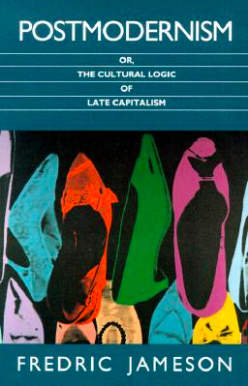At the end of Fredric Jameson’s Postmodernism, or The Cultural Logic of Late Capitalism (1991) it is stated, as many times in the book, what a possible definition of postmodernism might be: “The postmodern may well in that sense be little more than a transitional period between two stages of capitalism, in which the earlier forms of the economic are in the process of being restructured on a global scale, including the older forms of labor and its traditional organizational institutions and concepts” (417). From this perspective, postmodernism is also a form of interregnum, since both share a level of uncertainty, at least when it comes to naming what or who is the new ruling name in town. In a way, Jameson’s book offers a continuation of what the Political Unconscious inaugurated, that is, a task of constantly historizing. Not surprisingly, this is precisely what Jameson states in the “Introduction”, since he writes thinking for an age that has forgotten how to think historically (ix). The task, then, for a postmodernism thinking is to realize how much of the past has persisted while at the same time acknowledging that commodity critique became another form of mere consumption. This means, of course, that the ultimate form of capitalism (Jameson’s post-industrial capitalism, aka, third stage of capitalism) is able to melt in the everything, that critique is just another object of consumption in a pure form, since “postmodernism is the consumption of sheer commodification as a process” (x).
As much as the book seeks to theorize, or, at best, illustrate, what postmodernism might be, it also constantly returns to modernism. If postmodernism is supposed to be understood via historicity, there is no other way than learning the past of that form that could be anywhere. This means that since postmodernism is a “cultural dominant: a conception which allows for the presence and coexistence of a range of very different, yet subordinate features” (4), it hardly is foreseeable whilst also it is always present. Modernism, as an aesthetic form and content, might have challenged the ways and means of production, in the other hand, postmodernism emerges as a form of production that integrates into commodity production the aesthetic. It could be said then that postmodernism is (third stage) capitalism’s craving for the past, present and future, without clearly being able to produce its own historicity.
Postmodern products (novels, films, buildings and so on) resist interpretation. For instance, about the postmodern novel, Jameson would say that it not only resists interpretation but that it “is organized systematically and formally to short-circuit an older type of social and historical interpretation which it perpetually holds on and withdraws” (23). Without, saying it, Jameson’s suggests that the postmodern is a discourse constantly hesitating, something that needs to cut with the old while sustaining it. Postmodern, in its own expression, has a level of undecidability —as much as Jameson refuses to use the deconstructive term (Cfr. Chp. 7). What is at stake when analyzing postmodern art, is not only its form but the way it also depicts the mode of production that produced it, namely a machine that is obsessed with the process of processes of reproduction. Art no longer holds together a monumental enterprise (if it ever did) but now it “reshuffles the fragments of preexistent texts […] in some new and heightened bricolage: metabooks which cannibalize other books, metatexts which collate hits of other texts” (96). Postmodernism ultimately is the addition of dispersed elements, a summatory of things that are distant in time and yet close to our senses. Living in postmodernism times is living distracted, eternally gone in-between the “wrapping shells” of non-centered spaces that demand our centrality and linearity as subjects of production-distribution-consumption.
While it could be argued that Jameson too easily totalizes the production of culture in the late capitalism, it could also be said that this is not the project of postmodernism, or at least not the postmodernism that Jameson’s proposes. Jameson is aware that he must avoid auto-reification: “Permanent revolution in intellectual life and culture means both that impossibility and the necessity for a constant reinvention of precautions against what my tradition calls conceptual reification” (401). To this extend, thinking about postmodernism might, at best, open the possibility of reading literature (and history) as a series of movements and strategies. Thus, against reifying postmodernism, it should be thought beyond it. That is, if modernism was the movement and formation of monuments and its attractive force; postmodernism would come to be as an affective movement that brakes and disperses while sustaining what cuts. It might be said, then, that our current times (or even after the 60’s which are the times that Jameson analyzes the most), could be catalogued as a suspension and (another) regression (and return), from the brake of the postmodern and the fascination of the modern. We are not living the times of the “effacement of the traces of production” (314), as in postmodernism times we certainly did, but the times were scars are too visible, when what is effaced still accumulates, when non-subjects still matter and the global suspends the monad. And yet, the suspension (or stasis) of our times replicates more than nothing all that past that was supposed to be meted in the air, but somehow found us via partial summing ups.

